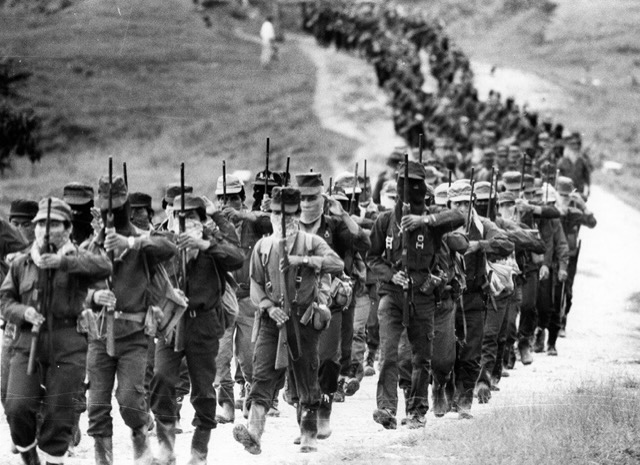by Hermann Bellinghausen
San Cristóbal de Las Casas, Chiapas

29 years have passed since the armed uprising and declaration of war against the Mexican State by the Zapatista Army of National Liberation (EZLN) in the mountains of Chiapas. Six presidents and nine governors later –and so much water under the bridges at both national and local levels since the dawn of January 1, 1994– the challenge posed by the insurgent Mayan peoples continues to be valid. And their audacious and working autonomy has just celebrated its 28th anniversary. On December 19 of that same year, the creation of the first 38 autonomous rebel municipalities was announced.
That which was born as an experiment of self-government of the indigenous peoples –which the State has never recognized and for seasons has openly fought against using the armed forces and police at all levels– is still in force in 2023. The rebel municipalities persist, different from the beginning, but the same. La Jornada made a tour of the regions of some of the at least 12 current Zapatista caracoles and was able to observe the vitality of this autonomy.
In 1995, after the military occupation of the Zapatista communities and the destruction of the Aguascalientes in the Tojolabal community of Guadalupe Tepeyac, by orders of President Ernesto Zedillo, the EZLN created five Aguascalientes, and around them regionally organized their autonomy.
What began as an armed action, for many even suicidal, resulted in new forms of indigenous self-management against the rampant neoliberal spring into which the PRI governments claimed to have propelled Mexico. After the San Andres Accords in 1996, Zapatista autonomy was established in practice by adopting as law the agreements signed and then betrayed by the Zedillo government. This autonomy was seen, with good reason, as an obstacle to the transnational and national megaprojects to come.
The police, military and paramilitary aggressions against the rebel municipalities are memorable. Tierra y Libertad, Ricardo Flores Magón, San Juan de la Libertad, San Pedro Polhó and San Pedro de Michoacán are among those that suffered the most violence and dispossession. Even so, these governments continued, establishing their own systems of justice, health, education, transportation and management of the land and its products.
A large part of these autonomous spaces were, and are, on lands recovered from the farmers and ranchers of the Lacandon jungle after the uprising almost three decades ago. Many others are made up of communities in the traditional zones of the highlands, the northern zone, the jungle itself and the border region of Chiapas. Choles, Tseltales, Tsotsiles, Tojolabales and Zoques who embarked on the resistance.

Administration after administration, government projects and programs have sought to economically and institutionally undermine the world’s most unique indigenous autonomy. In August 2003, another turn of the screw was announced with the creation of the caracoles, new centers of government in the five existing Aguascalientes. This is how the Good Government Councils were born, around which the Zapatista munici-municipalities were reorganized.
The experience would prove very useful in facing the new governmental onslaughts following the declaration of war by the government of Felipe Calderón against organized crime, which in principle meant militarily surrounding the country’s indigenous communities and the virtual paralyzation of the National Indigenous Congress. With Peña Nieto would come the Crusade against Hunger, a new version of economic counterinsurgency. In 2019 and 2020, now during the term of Andrés Manuel López Obrador, the EZLN established new caracoles and councils of good government, until there were at least 12, and a redistribution of its municipalities.
Now it is the new Morena state and federal governments that compete for followers through the electoral route (to which the Zapatistas never go) and promote a renewed partisanship of municipalities and indigenous communities, as well as through the economic route by means of social and welfare programs, to which the Zapatista resistance has remained impervious through peaceful and organized means.
Originally published in Spanish in La Jornada on December 31st, 2022. https://www.jornada.com.mx/2022/12/31/politica/008n1pol English translation by Schools for Chiapas and Chiapas Support Committee.
